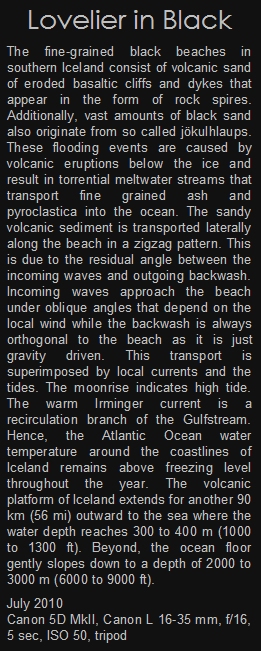

Lovelier in Black
The fine-grained black beaches in southern Iceland consist of volcanic sand of eroded basaltic cliffs and dykes that appear in the form of rock spires. Additionally, vast amounts of black sand also originate from so called jökulhlaups. These flooding events are caused by volcanic eruptions below the ice and result in torrential meltwater streams that transport fine grained ash and pyroclastica into the ocean. The sandy volcanic sediment is transported laterally along the beach in a zigzag pattern. This is due to the residual angle between the incoming waves and outgoing backwash. Incoming waves approach the beach under oblique angles that depend on the local wind while the backwash is always orthogonal to the beach as it is just gravity driven. This transport is superimposed by local currents and the tides. The moonrise indicates high tide. The warm Irminger current is a recirculation branch of the Gulfstream. Hence, the Atlantic Ocean water temperature around the coastlines of Iceland remains above freezing level throughout the year. The volcanic platform of Iceland extends for another 90 km (56 mi) outward to the sea where the water depth reaches 300 to 400 m (1000 to 1300 ft). Beyond, the ocean floor gently slopes down to a depth of 2000 to 3000 m (6000 to 9000 ft).
July 2010
Canon 5D MkII, Canon L 16-35 mm, f/16, 5 sec, ISO 50, tripod




















